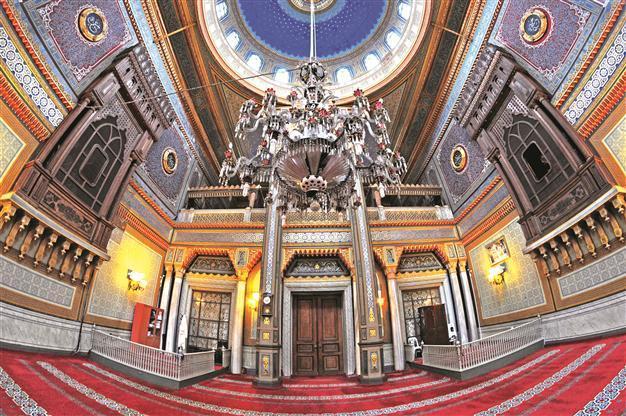Yıldız Palace Museum to become a star attraction with new project
ISTANBUL - Anatolia News Agency

Thanks to the European Union-supported project, vsitors will be able to discover the Yıldız Palace with 360-degree panorama photographs. Information kiosks and monitors giving information about the palace will also be placed in the palace.
"The Treasures of Yıldız Palace Revealed” will attract more visitors to the palace using modern technology to share the history of the palace with the widest possible audience.
Yıldız Palace’s museum manager, Ali İlker Tepeköy, told Anatolia news agency the project, the second European Union-supported effort at the palace, would include information kiosks and monitors giving information about the palace. Brochures will be made in four different languages and a new website has been launched.
Visitors will be able to discover the palace with 360-degree panorama photographs. “We would like to launch new projects and start a new era for the palace,” said Tepeköy, adding that the museum would use more technology to be more accessible to society. He also said the Yıldız Palace Foundation was celebrating its 30th year.
The project to open more parts Yıldız Palace is a vast complex of former imperial Ottoman pavilions and villas in Istanbul, Turkey, built in the 19th and early 20th centuries. It was used as a residence by the sultan and his court in the late 19th century. The palace was used as a center of the Ottoman Empire by Abdülhamid II for 33 years.
The new project aims to open more parts of the palace and make it one of Istanbul’s major palaces.
The origin of the palace, which was built in 1880 and was used by the Ottoman Sultan Abdülhamid II, will be emphasized. Its place as the last palace built by the Ottoman Empire will also be explained.
The natural woodlands on the palace grounds, which became an imperial estate during the reign of Sultan Ahmed I (1603-1617), will be restored.
It is known that in the late 19th century, Abdülhamid II left Dolmabahçe Palace because he feared a sea attack on the palace, which is located on the shore of the Bosphorus strait.
He expanded Yıldız Palace and ordered the renowned Italian architect Raimondo D’Aronco to add new buildings to the palace complex. When he moved there, the palace became the fourth seat of Ottoman government (the previous ones were the Eski Saray (Old Palace) in Edirne, and the Topkapı and Dolmabahçe palaces in Istanbul.)
Various sultans after Ahmed I enjoyed vacationing on these lands and Abdülmecid I and Abdülaziz built mansions here.
The new project will be done within the framework of the European Union’s Intercultural Dialogues and Museum Grant Program. The new project will make the palace a more visible attraction in Istanbul. In the future, innovations and restorations will be done to reach to a wider audience.
About Yıldız Palace
The palace is a complex of buildings including the State Apartments (Büyük Mabeyn), Şale Pavilion, the Malta Pavilion, the Çadır Pavilion, the Yıldız Theater and Opera House, the Yıldız Palace Museum, and the Imperial Porcelain Factory. The Yıldız Palace Gardens are also a popular public site among the residents of Istanbul. A bridge connects the Yıldız Palace with the Çırağan Palace on the Bosphorus through the palace gardens. The sultan’s residence was in the Şale Kiosk or pavilion. The building has two floors and a basement and is constructed from a mix of wood and stone. It was constructed in three phases. The Malta Kiosk, a pavilion located in Yıldız Park, was built by Sultan Abdülaziz, who used it as to detain his predecessor.
